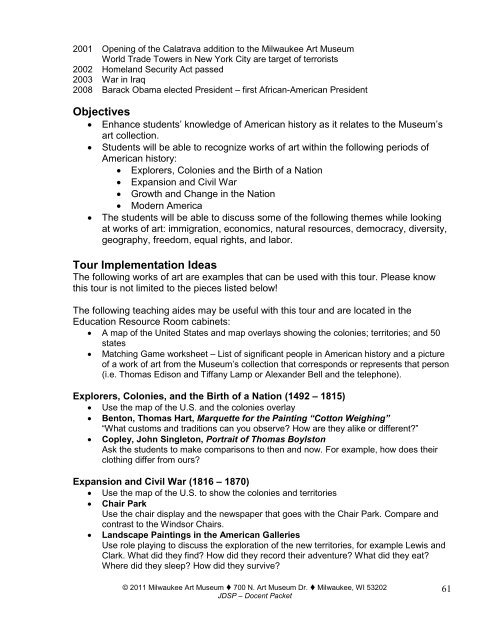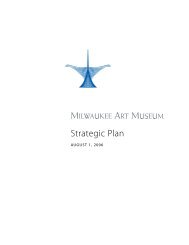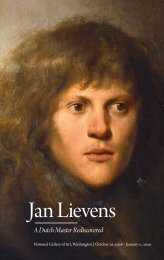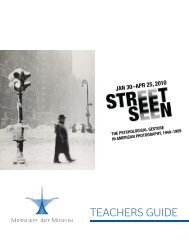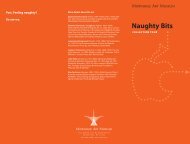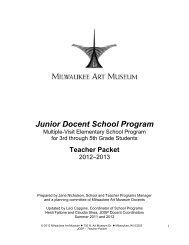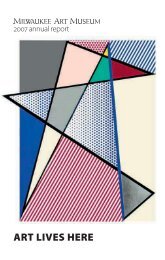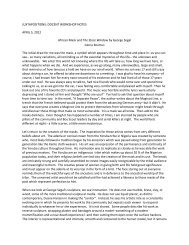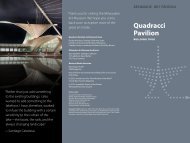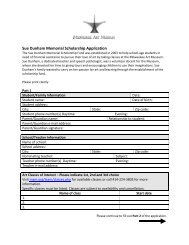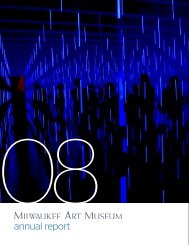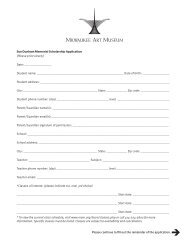Junior Docent School Program - Milwaukee Art Museum
Junior Docent School Program - Milwaukee Art Museum
Junior Docent School Program - Milwaukee Art Museum
Create successful ePaper yourself
Turn your PDF publications into a flip-book with our unique Google optimized e-Paper software.
2001 Opening of the Calatrava addition to the <strong>Milwaukee</strong> <strong>Art</strong> <strong>Museum</strong><br />
World Trade Towers in New York City are target of terrorists<br />
2002 Homeland Security Act passed<br />
2003 War in Iraq<br />
2008 Barack Obama elected President – first African-American President<br />
Objectives<br />
<br />
<br />
<br />
Enhance students‟ knowledge of American history as it relates to the <strong>Museum</strong>‟s<br />
art collection.<br />
Students will be able to recognize works of art within the following periods of<br />
American history:<br />
Explorers, Colonies and the Birth of a Nation<br />
Expansion and Civil War<br />
Growth and Change in the Nation<br />
Modern America<br />
The students will be able to discuss some of the following themes while looking<br />
at works of art: immigration, economics, natural resources, democracy, diversity,<br />
geography, freedom, equal rights, and labor.<br />
Tour Implementation Ideas<br />
The following works of art are examples that can be used with this tour. Please know<br />
this tour is not limited to the pieces listed below!<br />
The following teaching aides may be useful with this tour and are located in the<br />
Education Resource Room cabinets:<br />
A map of the United States and map overlays showing the colonies; territories; and 50<br />
states<br />
Matching Game worksheet – List of significant people in American history and a picture<br />
of a work of art from the <strong>Museum</strong>‟s collection that corresponds or represents that person<br />
(i.e. Thomas Edison and Tiffany Lamp or Alexander Bell and the telephone).<br />
Explorers, Colonies, and the Birth of a Nation (1492 – 1815)<br />
Use the map of the U.S. and the colonies overlay<br />
Benton, Thomas Hart, Marquette for the Painting “Cotton Weighing”<br />
“What customs and traditions can you observe? How are they alike or different?”<br />
Copley, John Singleton, Portrait of Thomas Boylston<br />
Ask the students to make comparisons to then and now. For example, how does their<br />
clothing differ from ours?<br />
Expansion and Civil War (1816 – 1870)<br />
Use the map of the U.S. to show the colonies and territories<br />
Chair Park<br />
Use the chair display and the newspaper that goes with the Chair Park. Compare and<br />
contrast to the Windsor Chairs.<br />
Landscape Paintings in the American Galleries<br />
Use role playing to discuss the exploration of the new territories, for example Lewis and<br />
Clark. What did they find? How did they record their adventure? What did they eat?<br />
Where did they sleep? How did they survive?<br />
© 2011 <strong>Milwaukee</strong> <strong>Art</strong> <strong>Museum</strong> 700 N. <strong>Art</strong> <strong>Museum</strong> Dr. <strong>Milwaukee</strong>, WI 53202<br />
JDSP – <strong>Docent</strong> Packet<br />
61


